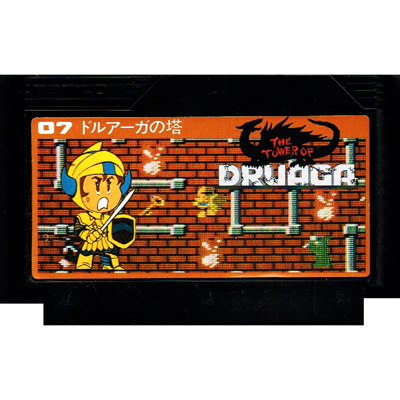THE TOWER OF DRUAGA FAMICOM
THE TOWER OF DRUAGA FAMICOM - NAMCOT#07
The Tower of Druaga (Doruāga no Tō) is a maze-based action role-playing arcade game released by Namco in 1984. It is the first game in the Babylonian Castle Saga series, inspired by Sumerian and Babylonian mythology, including the Epic of Gilgamesh and Tower of Babel.
It was conceived as a "fantasy Pac-Man" with combat, puzzle-solving and subtle role-playing elements. The Tower of Druaga was a success in Japan, where it attracted millions of fans, with its mix of arcade action and role-playing elements. It laid the foundations for the action role-playing game genre, as it largely began the trend of combining arcade-style action mechanics with RPG elements. It inspired a number of action role-playing games, including Dragon Slayer, Courageous Perseus, Hydlide, and Ys, as well as The Legend of Zelda, in addition to Dragon Quest creator Koichi Nakamura.
The Tower of Druaga runs on Namco Super Pac-Man hardware but with a video system like that used in Mappy, and is the first game from Namco to display its year in Roman numerals on the title screen. It was later ported to the MSX, Famicom and remade for the PC Engine platform by Game Studio. Its first appearance outside Japan was in the third compilation of the Namco Museum Volume series for the PlayStation and also appears on Namco Museum compilations for Nintendo DS, PSP, and Xbox 360.
Originally the game and its sequels had no specific setting other than "the tower". However, in recent years, the series has been retconned as being set in the fantasy kingdom of "Babylim". A 2008 anime series, beginning with The Tower of Druaga: The Aegis of Uruk, uses the game as its back story, though is set many decades later.
The player assumes the role of the hero Gilgamesh, whose goal is to rescue the maiden Ki (カイ Kai) from the demon Druaga. To do this, he must traverse through 60 floors of an immense tower. Gilgamesh comes equipped with a sword, which he can use to defeat monsters, and a shield, which can be used to block magical attacks. The monsters get progressively more difficult as the game progresses, beginning with simple slimes and culminating with Druaga himself. Each floor consists of a maze filled with monsters, and a randomly placed locked door leading to the next level. The player must navigate through the maze to find a randomly placed key that unlocks the door. In addition, each floor contains a hidden treasure, which appears once the player has performed a specific requirement. The player's starting position is also randomly determined; however, the hidden treasure always appears in the same position the player starts from when revealed. The mazes themselves are not random, but there are various predetermined patterns. Some of the treasures are merely helpful items, some are detrimental, and some are essential to completing the game including the Blue Crystal Rod, the game's most important item; without it, Druaga will not appear and the player will be forced to return to an earlier floor, known as "zapping". Players may also lose a life in a number of ways.
The regular enemies are slimes, magicians, ghosts, knights, lizard men, ropers (which look like huge blobs with tentacles), and dragons (the main being Quox).
In the third Namco Museum game, there is a small handbook explaining how to get the treasures. There is also a hidden version far more difficult than the regular named "Another Tower" and an extra version named "Darkness Tower". The treasures (save the first one) are all altered in how to get. In the museum's library, there are three books containing illustrations of the game's characters. The Namco Museum DS version does not have a physical handbook, but the actual game does feature a "hint mode" for getting the treasures.
On some early releases of the arcade version there is a glitch that makes the last level unbeatable.
ENDAST KASSETT

